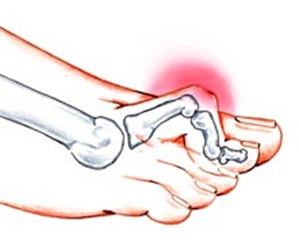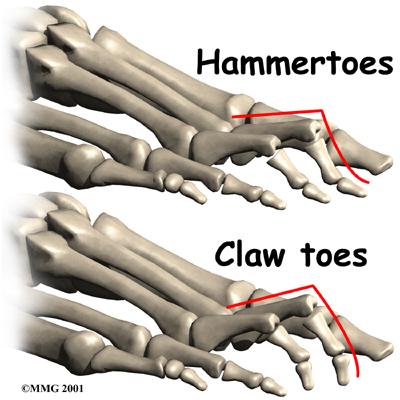Characterized by a bending of one or both joints of any but the big toe, a Hammertoe is a common podiatric condition. This condition causes difficulties wearing shoes, which often exacerbate the problem. If you suffer from hammertoes, you may notice one or more of the following symptoms:
Corns or painful hard bumps between the affected toes or on the top, side or end of the toes. Corns are a buildup of skin caused by pressure at the contact point between the toe and shoe.

Calluses on the bottom of toes or on the ball of the foot. Calluses are rough, dry patches of dead skin that builds up in areas of increased friction and pressure.
Pain or irritation when the toes come into contact with the shoe.
Hammertoes and their symptoms generally worsen over time, as the pressure between the foot and footwear becomes more severe. If left untreated, they can become rigid and open sores may develop. If you are suffering from this condition, it is important to seek help sooner rather than later as they will not heal without treatment of some kind.
Treatment options include custom foot orthotics, changing footwear, padding the corns and calluses that form, trimming and/or removing the corns and calluses that form, use of anti-inflammatory medications for pain, and splinting the affected toe. Surgery is recommended in some severe cases. Be sure to speak to your Chiropodist/Foot Speciliast about the right treatment plan for you.
Toe Deformities
Some ailments of the feet are easily disguised and can go untreated for years. However, there are a few that need to be treated in the earliest stages to get any relief from the symptoms.
For example, fairly common diseases of the foot are known as toe deformities. These ailments are oftentimes caused by a muscle imbalance in the foot. This can be caused by several factors such as flatfeet, a traumatic injury, or disease of the toe joints.
Because the ailment of flat feet means that the foot is longer than that of a foot with a normal arch, the flexor muscles becomes overpowering. The toes are generally not strong enough to resist this tension which results in one of two deformities:
Claw toe – which happens when the middle bone is pulled downward causing the proximal and middle phalanges to buckle upward.
Hammertoe – which is when the proximal phalanx causes the outer two joints of the toe to bend downward.
If left untreated, these ailments can lead to other problems such as calluses or scenarios where two bones fuse together making the only treatment a painful surgery which can require weeks of recovery.
This diagnosis is best treated in the initial stages to avoid advanced development that may not be fixed with surgery.

Contact us today to see how we can alleviate foot pain caused by a hammertoe.

